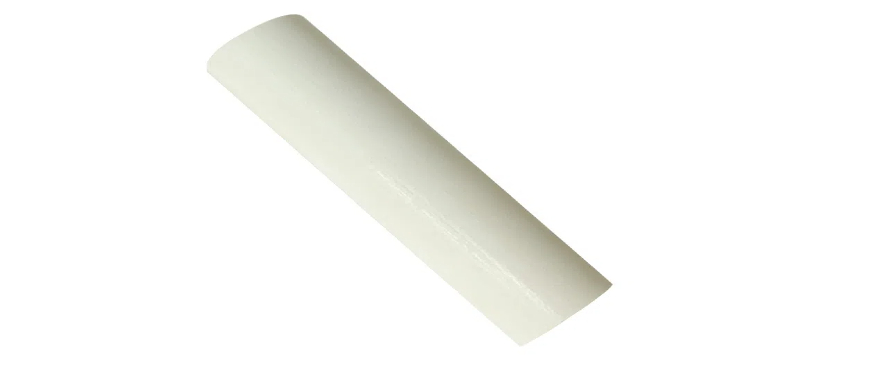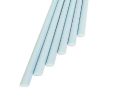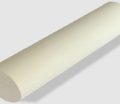
Fiberglass rods are versatile materials widely used in various industries, including construction, electrical, and industrial applications. Known for their strength, lightweight properties, and resistance to corrosion, fiberglass rods are ideal for reinforcing structures, framing, and other support functions. In these applications, understanding the modulus of elasticity fiberglass rod is crucial. This property measures the material’s stiffness and resistance to deformation under stress, helping engineers and manufacturers select the right fiberglass rod for each project. By considering the modulus of elasticity, professionals can ensure that the fiberglass rods will meet the specific mechanical demands of the task, ensuring both performance and longevity.
What is the Modulus of Elasticity Fiberglass Rods?
Definition
The modulus of elasticity fiberglass rod is a fundamental material property that quantifies a material’s ability to resist deformation when subjected to stress. Also known as the elastic modulus, this value measures how stiff a material is, or how much it will deform under a given amount of stress. In simple terms, the higher the modulus of elasticity, the less the material will stretch or compress when force is applied. For fiberglass rods, this property is crucial as it indicates the material’s ability to maintain structural integrity and resist bending or warping under load.
Importance in Fiberglass Rods
The modulus of elasticity of fiberglass rods is particularly important when selecting fiberglass rods for structural reinforcement and various applications in construction, electrical systems, and industrial uses. A fiberglass rod with a higher modulus of elasticity will provide greater stiffness and better support in structural applications, where minimal deformation is required. Conversely, a lower modulus may be more suitable for applications like universal trampoline fiberglass rods, which require controlled flexibility to ensure both durability and safe performance. Understanding the modulus of elasticity helps engineers and manufacturers choose the right type of fiberglass rod to meet the specific mechanical demands of their projects, ensuring both strength and durability.
Factors Affecting the Modulus of Elasticity Fiberglass Rods
Composition of Fiberglass
The modulus of elasticity fiberglass rod is significantly influenced by the composition of the fiberglass material, particularly the ratio of glass fibers to resin. Glass fibers are known for their strength and rigidity, while resins serve to bond the fibers and provide flexibility. The higher the proportion of glass fibers in the mixture, the stiffer the fiberglass rod will be, leading to a higher modulus of elasticity. In contrast, a higher resin content can reduce the overall stiffness, resulting in a lower modulus. The balance between these components directly affects the material’s ability to resist deformation under stress and is a key factor in determining the suitability of fiberglass rods for different applications.
Manufacturing Process
The modulus of elasticity fiberglass rod is also shaped by the manufacturing process, particularly the pultrusion method, which is commonly used to produce fiberglass rods. Pultrusion involves drawing continuous fibers through a resin bath, followed by curing in a heated die. The quality of this process can greatly affect the rod’s final modulus. Factors such as curing temperature, resin viscosity, and the alignment of the fibers influence how tightly the fibers are packed and how uniformly the resin bonds with the fibers. As a result, any inconsistencies during manufacturing can lead to variations in the stiffness of the final product. Therefore, careful control of the production process is essential to achieving the desired modulus of elasticity, ensuring that the fiberglass rods meet the specific mechanical requirements of the application.
Innovative Uses: Can You Reshape Fiberglass Rods Effectively
Measuring the Modulus of Elasticity Fiberglass Rods
Tensile Testing
One of the primary methods for measuring the modulus of elasticity fiberglass rod is through tensile testing. This process involves applying a tensile (stretching) force to a sample of fiberglass rod and measuring the resulting elongation. By plotting the stress (force per unit area) against the strain (deformation), the modulus of elasticity fiberglass rod is calculated as the slope of the linear portion of the stress-strain curve. This modulus represents the material’s stiffness—its resistance to stretching or compressing when subjected to an external load.
Tensile testing is conducted according to standardized methods, such as ASTM D638 (for plastics) or ISO 527, which are widely accepted for testing the mechanical properties of composite materials like fiberglass rods. These standards ensure that the test is carried out under controlled conditions, with specific dimensions for the test specimen and known testing speeds. Results from tensile tests allow engineers to interpret the mechanical properties of fiberglass rods, such as their strength, elasticity, and resistance to deformation, under various load conditions. This ensures the fiberglass rod’s suitability for structural or industrial applications.
Comparison with Other Materials
When evaluating the modulus of elasticity fiberglass rod, it’s also important to compare it to other materials commonly used in similar applications, such as steel, carbon fiber, and plastics. The modulus of elasticity for fiberglass rods is typically lower than that of steel, but it is higher than that of many plastics. In comparison to carbon fiber, fiberglass tends to have a lower modulus, but it also has advantages in cost-effectiveness and corrosion resistance.
Here is a comparison table to provide a clearer understanding of how fiberglass rods measure up:
| Material | Modulus of Elasticity (GPa) |
|---|---|
| Fiberglass Rods | 30-50 GPa |
| Steel | 200-210 GPa |
| Carbon Fiber | 120-160 GPa |
| Plastic (e.g., PVC) | 2-4 GPa |
As shown, modulus of elasticity fiberglass rod falls between plastics and steel, making it a versatile material for applications requiring a balance of strength and flexibility. This table helps in determining the best material based on specific project needs, whether it’s for structural reinforcement, electrical insulation, or other industrial uses.
Discover If Are Fiberglass Rods Used in Camping Chairs Cheap
Applications of Fiberglass Rods Based on Modulus of Elasticity Fiberglass Rod
Construction
The modulus of elasticity of a fiberglass rod plays a significant role in determining its suitability for construction projects, particularly as reinforcement bars in concrete. Fiberglass rods, with their high tensile strength and relatively high modulus of elasticity, are increasingly being used as an alternative to traditional steel reinforcement bars (rebar). The higher the modulus of elasticity of a fiberglass rod, the better its ability to resist deformation under stress, which is critical in ensuring the long-term stability and durability of concrete structures. Additionally, the high tensile strength of fiberglass rods enhances their performance, allowing them to bear heavy loads without breaking or stretching, further improving the resilience of reinforced concrete.
Fiberglass rods are especially advantageous in situations where corrosion is a concern, such as in bridges, coastal buildings, and tunnels. The modulus of elasticity fiberglass rod allows these reinforcement bars to maintain their shape and strength over time, even when subjected to environmental factors like moisture and salt exposure. As a result, the material is ideal for reinforcing concrete in marine and other harsh environments, offering durability without the risk of rust or deterioration.
Electrical and Plumbing
In the electrical and plumbing industries, fiberglass rods are often used for their lightweight, non-conductive properties. The low fiberglass rod weight combined with a high modulus of elasticity is particularly advantageous in applications that require the material to withstand bending without permanent deformation. For example, fiberglass rods are commonly used as pull rods for electrical wiring or for plumbing pipe installation in hard-to-reach spaces. Their reduced weight makes them easier to handle during installation, while still providing the necessary strength and durability.
The modulus of elasticity of fiberglass rods ensures that they can withstand repeated bending during use without breaking or losing their form. This is crucial in scenarios where flexibility is needed, but structural integrity must be maintained. Fiberglass rods are also valued for their resistance to corrosion, which is particularly beneficial in plumbing applications where exposure to water and chemicals is frequent.
Aerospace and Automotive
The modulus of elasticity fiberglass rod also makes it an excellent choice for use in lightweight structures in the aerospace and automotive industries. In these sectors, materials with low weight but high strength are crucial for improving fuel efficiency and performance. The ability of fiberglass rods to resist deformation under stress while maintaining a relatively low weight allows them to be used in structural components, such as support beams, frame reinforcement, and parts subject to significant loading.
In aerospace, fiberglass rods are often used in the construction of lightweight or non-load-bearing components and supports, where high strength and minimal weight are essential. Similarly, in the automotive industry, the elastic modulus of fiberglass rods ensures that fiberglass can be used in places like body panels, bumpers, and other components that require both strength and flexibility without adding excessive weight. These properties of fiberglass rods contribute significantly to the performance and fuel efficiency of aerospace and automotive designs, while also providing benefits in terms of energy absorption and safety in certain applications.
Long Fiberglass Rods: Essential Uses For Gardening
Choosing the Right Fiberglass Rod Based on Modulus of Elasticity Fiberglass Rod: Key Considerations for Material Selection
How to Select the Right Fiberglass Rod
Selecting the right modulus of elasticity fiberglass rod is crucial for ensuring optimal performance in various applications, whether it be for construction, electrical work, or specialized industrial uses. The modulus of elasticity fiberglass rod essentially defines the rod’s ability to resist deformation under stress, which is vital when choosing materials that will bear significant loads or face harsh conditions. Below are key considerations to take into account when selecting a fiberglass rod based on its modulus of elasticity.
Project Requirements and Load-Bearing Needs
The modulus of elasticity fiberglass rod plays a key role in determining how well the material will perform under load. For heavy-duty applications, such as reinforcement in concrete or load-bearing supports in construction, choosing a fiberglass rod with a higher modulus of elasticity will ensure that it can withstand significant stresses without excessive bending or deformation. In contrast, lighter applications, such as electrical wiring conduits or plumbing, may not require as high a modulus, but should still be chosen carefully to ensure flexibility without compromising strength.
Environmental Conditions
Fiberglass rods with a higher modulus of elasticity fiberglass rod are often more suitable for environments where they will be exposed to harsh conditions, such as extreme temperatures, moisture, or chemicals. For example, in marine or coastal construction projects, fiberglass rods that offer a high modulus of elasticity are preferred for reinforcement, as they can maintain their structural integrity despite exposure to saltwater or fluctuating temperatures. Additionally, fiberglass rods used in aerospace or automotive applications should be selected for their ability to resist deformation under dynamic loads, where both strength and flexibility are required.
Application Type and Industry Standards
Different industries and applications have varying standards for the modulus of elasticity required in fiberglass rods. In construction, higher modulus rods are typically used for structural reinforcement, while electrical and plumbing applications often require rods that offer a balance of flexibility and strength. The modulus of elasticity fiberglass rod should also align with industry standards to ensure compliance with safety regulations and durability expectations. For instance, in the electrical industry, fiberglass rods are often used as pull rods for wiring, where moderate modulus values are needed to provide both flexibility and resistance to bending.
Cost vs. Performance
While fiberglass rods with higher modulus of elasticity fiberglass rod tend to offer better performance in demanding applications, they are often more expensive. When selecting a fiberglass rod for a specific project, it’s important to weigh the cost against the expected performance benefits. For lighter applications where the stresses on the fiberglass rod are lower, a rod with a lower modulus of elasticity might be sufficient, potentially offering a more cost-effective solution. Conversely, for projects that require higher durability and resistance to deformation, investing in a rod with a higher modulus may offer long-term savings due to its increased longevity and reliability.
FAQs about Modulus Of Elasticity Fiberglass Rod
The modulus of elasticity of GFRP (Glass Fiber Reinforced Polymer) bars is a key material property that defines the bar’s ability to resist deformation under stress. Typically, the modulus of elasticity for GFRP bars ranges from 2.5 million PSI to 3.0 million PSI, depending on the specific type of glass fibers used and the manufacturing process. This value is significantly lower than that of steel, which makes GFRP bars suitable for applications where lower stiffness is acceptable or where reducing weight is a priority, such as in bridge construction or in the reinforcement of concrete structures.
The lower modulus of elasticity of GFRP bars offers several benefits, including enhanced resistance to corrosion, making them ideal for environments where metal reinforcement would degrade over time, such as marine or underground structures. However, this property also means that GFRP bars are more flexible than steel, which must be considered when using them for structural reinforcement. Understanding the modulus of elasticity helps engineers determine how much the bars will bend or deform under load, ensuring that the right materials are used for specific design requirements.
The elasticity of fiberglass refers to its ability to return to its original shape after being deformed under stress. This is quantified through the modulus of elasticity, a property that describes the material’s stiffness or resistance to deformation. Fiberglass is a composite material typically made from glass fibers embedded in a resin matrix. The elasticity of fiberglass is determined by the type of glass fibers used (such as E-glass or S-glass), the resin system, and the fiber orientation.
In general, fiberglass is known for its high tensile strength and relatively low modulus of elasticity compared to materials like steel or carbon fiber. This makes it a more flexible option for certain applications, such as reinforcement in concrete structures or electrical conduit installations. While fiberglass can bend without breaking, its elasticity is not as high as metals like aluminum or steel, which are often preferred for applications requiring high stiffness and minimal deformation. The balance between strength and elasticity makes fiberglass an ideal material for use in applications that need both flexibility and durability.
To calculate the modulus of elasticity of fiberglass, a tensile test is commonly performed. The modulus of elasticity (E) is determined by measuring the stress-strain relationship of the fiberglass specimen. The formula for the modulus of elasticity is given as:
E=StrainStressWhere:
Stress is the force applied per unit area, typically measured in PSI (pounds per square inch) or Pascals (Pa).
Strain is the deformation of the material relative to its original length, typically expressed as a percentage or dimensionless ratio.
For fiberglass, the test is usually conducted under controlled conditions using a sample that is pulled until it deforms. The stress is applied, and the strain is measured using specialized equipment like extensometers. The modulus of elasticity for fiberglass can vary depending on the type of glass fibers, the resin used, and the processing methods, but it typically ranges between 2.5 million to 3.0 million PSI for standard fiberglass materials.
The calculated modulus value is important for determining how much a fiberglass component will bend or stretch under a given load, which is essential for designing structures and products that require specific material performance characteristics.
The modulus of elasticity of fiberglass is typically expressed in PSI (pounds per square inch) and is an indicator of the material’s stiffness. For most fiberglass products, the modulus of elasticity generally falls within the range of 2.5 to 3.0 million PSI. This value is significantly lower than that of materials like steel, which has a modulus of elasticity of about 30 million PSI. This means that fiberglass is more flexible and can bend or deform more under stress, making it ideal for applications where some level of flexibility is desired.
The specific value of the modulus of elasticity can vary depending on several factors, including the type of fiberglass used (such as E-glass or S-glass), the resin matrix, and the way the fiberglass is processed during manufacturing. For example, fiberglass rods used in construction, marine environments, or aerospace applications may have different modulus values based on their intended use. The lower modulus of elasticity of fiberglass allows it to absorb more energy and adapt to forces without breaking, which is why it’s commonly used in products like GFRP (Glass Fiber Reinforced Polymer) bars, where flexibility and strength are both required.
Understanding the modulus of elasticity in PSI is crucial for engineers and designers to select the appropriate fiberglass material that can meet the structural and functional requirements of a specific project.

As the editor of GangLong Fiberglass, I have years of experience and in-depth research, focusing on cable tray products, fiberglass solutions, and grille systems. I incorporate years of industry insights and practical experience into every content, committed to promoting the progress of the industry. At GangLong Fiberglass, my commitment is reflected in every product, from innovative cable trays to durable fiberglass solutions and sturdy grille systems. As an authoritative voice in the industry, my goal is to provide valuable information to professionals and businesses and promote forward-looking solutions.


